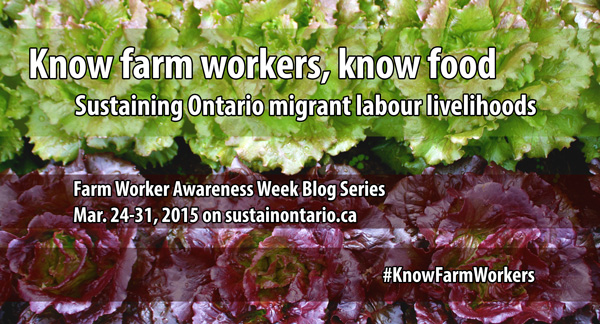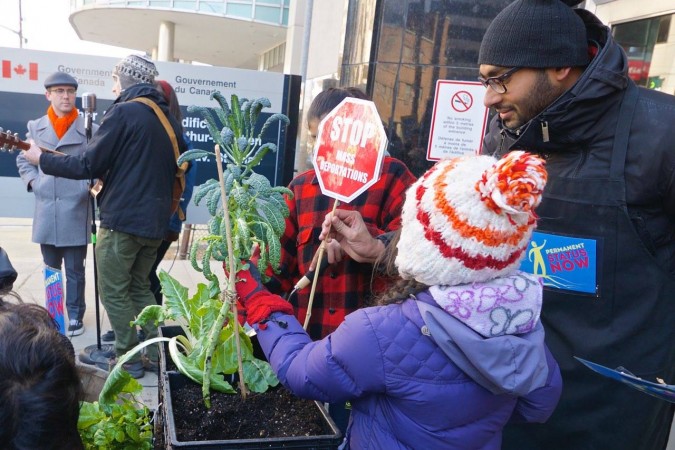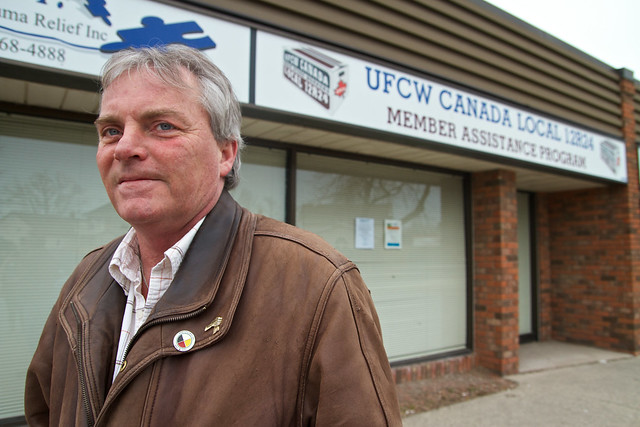Levelling the field: Filling Ontario’s policy gaps in migrant farm worker rights
Posted: March 31, 2015
Categories: GoodFoodBites / News from Sustain Ontario

As part of Farmworker Awareness Week (March 24-31st, 2015), this blog series highlights some of the ideas we have gathered over the past several months on promoting healthier, more sustainable farm worker livelihoods. Check out the bottom of this post for background detail on this community research partnership between Sustain Ontario and the University of Toronto.
In our earlier post on migrant farm worker health, we underscored how responsibilities for ensuring migrant farm worker rights and social protections at various levels of jurisdiction can be a ‘hot potato’ issue. With this in mind, in today’s post we hone in on three overarching – and sometimes controversial – areas of policy change that some advocates argue would help to fill the gaps in the jurisdictional maze. Specifically, we take a closer look at citizenship, unionization, and changes to Employment Standards and Occupational Health and Safety.
Citizenship
Tomorrow, thousands of migrant workers in Canada face a mass deportation.
April 1st is the first day that legislation introduced by the federal government in 2011 will come into effect. The “4 & 4 rule” mandates that people hired through low-skilled streams of the federal Temporary Foreign Worker Program can only work in Canada for four years at a time, followed by four years of ineligibility for the program. Although the 4 & 4 rule is expected to have a heavy impact on those employed in farming in general, it does not apply to approximately 73% of migrant farm workers who are hired through the Seasonal Agricultural Worker Program (SAWP). It does, however, apply to many farm workers hired each year through non-SAWP streams of the Temporary Foreign Worker Program. Based on 2012 figures, this includes nearly 10,000 farm workers, not all of whom are currently in Canada.
In a recent CBC article, CEO of Mushroom Canada Bill Stevens underscored the likely harmful impact of the 4 & 4 rule on the $900-million mushroom industry, which depends heavily on migrant farm workers. Stevens has been advocating for a moratorium on the April 1st deadline, arguing that migrant farm workers should have access to permanent residency: “Frankly, it’s a crisis with us because we’re losing workers who don’t want to leave, who have proven themselves to be valuable, and deserve an opportunity to apply for citizenship.”

A protest against the ‘4 and 4 rule’ outside of Citizenship and Immigration Canada in Toronto on March 29th. Protesters planted food to symbolize migrant workers’ rootedness in our communities. Photo courtesy of Murray Lumley.
Across the country, grassroots migrant justice organizations have been issuing parallel calls for a moratorium against the 4 & 4 rule. The Campaign Against the 4 Year Limit on Migrant Workers is led by a collective of organizations that work directly with migrant workers, such as Justice for Migrant Workers, which we highlighted in our post on food justice. They have organized protests and a petition demanding permanent residency for current and future migrants, along with access to social benefits and entitlements.
Calls for immigration reform are more commonly heard in reference to the United States. So how does migrant farm worker employment in Canada stack up against the U.S. context?
Compared to the United States, very few farm workers in Canada have an immigration status constructed as ‘undocumented’ or ‘illegal.’ In the United States, an estimated 50% of farm workers are undocumented. This label makes it difficult for farm workers to access civic participation, upward economic mobility and basic social benefits for themselves and their families. The H-2A program offers a legal temporary visa and, at least in theory, it is meant to ensure contractually guaranteed free housing, meals, and access to U.S. workers’ compensation and other standards. However, H-2A workers made up only 6% of the 2012 hired agricultural workforce. The program is unpopular with social justice activists, who underscore labour and human rights violations, as well as employers, who say it is onerously bureaucratic. Recent immigration reform by the Obama administration does not, by and large, improve prospects for migrant farm workers in the United States.
An anonymous representative at a farm organization compares Canada’s SAWP favourably to the U.S. He recalls, “When we’ve been in conversation with Americans, they wish they could have a program like us, they’re impressed with ours. Ontarians should also be impressed because it [the SAWP] works well.”
However, others point out shortcomings of the Canadian temporary farm worker program. Some say it is fair to hold Canada to a higher standard than the U.S. because a) Canada does not share a border with Mexico; b) due to the structure of its parliament it faces less gridlock to immigration reform; and c) it has legally committed to a policy of multiculturalism. Food system sustainability organizations like Food Secure Canada and migrant justice groups have argued that migrant farm workers hired through either SAWP or non-SAWP streams should have the option of becoming permanent residents and citizens. They propose that while formal Canadian citizenship doesn’t guarantee equal access to a flourishing life, it provides a better chance of ensuring the government upholds farm workers’ rights, that their skills and contributions are valued, and that migrants would no longer face protracted separation from their families each season.
Some farmers, including Jenn Pfenning of Pfenning’s Organic Farm, would like to see similar immigration policy changes (check out this post for our interview with Pfenning). Although citizenship generally falls under federal jurisdiction, provinces have some discretion through the Provincial Nominee Program. Ottawa mushroom farmer Fernando Medeiros indicates he has shelled out $10,000 in legal fees in attempting to secure permanent residency for two farm employees through the Provincial Nominee Program. So far, his attempt has been unsuccessful. What is more, because he hired these two employees through non-SAWP streams of the Temporary Foreign Worker Program, they now face the looming April 1st deadline.
Collective bargaining and unionization

Stan Raper, National Coordinator of the Agriculture Workers Alliance. Photo: Peter Haden, Creative Commons.
Some migrant farm workers have contributed to Ontario’s rural communities each season for as long as three decades, and yet even they lack access to permanent residency or citizenship. Stan Raper is the National Coordinator of the Agriculture Workers Alliance, a national association operated by Canada’s United Food and Commercial Workers (UFCW) union that engages in legal advocacy, direct support for farm workers (unionized and non-unionized) and community outreach. He notes that the UFCW has helped hundreds of unionized migrant workers employed in meat processing plants access permanent residency through the Provincial Nominee Program, primarily in the prairie provinces. However, Ontario farm workers are excluded from the legislation that governs collective bargaining and union certification. This means that in effect they cannot unionize in Ontario. In BC, where farm workers can legally unionize, the Mexican government was found guilty of illegally blacklisting migrant farm workers whom it suspected of being union sympathizers.
Many migrants report being afraid of speaking up about problems they encounter with working conditions and employer-provided housing because they risk spoiling their chances of being ‘named’ by an employer to return the next year. Joining a union can mean that a worker will not get rehired in future years. Still, Raper argues that unionizing is one way of better protecting migrant farm workers’ rights and reducing the precariousness that comes with their temporary citizenship status. “There are calls for status, there are calls for stopping the cycle of temp foreign workers by allowing people to stay. We argue, in our union, that a collective bargaining process allows a grievance procedure: No repatriation without a grievance step.”
Despite the challenges of building union membership in a labour program that is seasonal and discourages workers from advocating for their own workplace rights, Raper contends, “The only time that I have seen the results that I think [migrant farm] workers are looking for and are trying to achieve is by re-writing the contract. And the only way that I know of to rewrite the contract is to unionize those workers and write a contract with the employer directly. And so you get a grievance procedure: if there’s a problem, they have steps that they’ve agreed that they’re going to go through, they have seniority, and they have recall rights. And so the ‘naming’ process is eliminated.”
But farmers and farm industry organizations often argue that unionization is not the way to go in agricultural labour contexts. An anonymous representative from a farm industry organization states, “People decry preventing unionizing, but when you’re working with living organisms, you can’t just shut things down when there is a dispute.” He adds that unionizing is not the sole means of dealing with a labour disputes.
Employment Standards, Occupational Health & Safety
Migrant farm work is frequently referred to as ‘precarious,’ meaning migrants often have weak access to social protections, low remuneration, and sometimes little control over their working hours. A precarious citizenship status also makes it difficult for migrants to shape decision in the workplace – and the food system at large – that affect their lives. An announcement in February from the Ontario Ministry of Labour thus came as welcome news to labour advocates: the Ministry intends to review the Employment Standards Act to better protect people employed in precarious forms of work.
Farm workers in Ontario are exempt from numerous employment standards, including those governing minimum wages, overtime pay, and vacation pay. In addition, until as recently as 2006, farming operations in Ontario were exempt from the Occupational Health and Safety Act. At present, the Act gives farm workers four basic rights: The right to participate in identifying workplace concerns; the right to know about potential worksite hazards; the right to refuse dangerous work; and the right to stop work that is dangerous to any worker.
“Really? That’s the best we can do in Ontario in 2014?”, queries Stan Raper in reference to the Act. He adds, “Since 2006, farm workers, whether they’re from Ontario, or from Jamaica or Mexico, have had the right to refuse dangerous work. There hasn’t been one work refusal, ever under that legislation, in what? How many years? Almost ten years. . . . Why do you think no one is refusing dangerous work? Well the fear is there, that if they refuse that work, they’re going home. And that’s how real it is, even when you have that basic piece of legislation, without the regulations defining what a dangerous job is, no one’s prepared to take that step. . . . Right now they [migrant farm workers] don’t have a lot of rights, so we need to establish those rights.”
5 Key ideas proposed by farmers, migrant justice groups and union labour for Ontario’s food movement to advance migrant farm worker health equity, safety and dignity:
- 1. Change the ‘4 and 4 rule.’ This rule affects farm workers hired under low-skilled agricultural streams of the Temporary Foreign Worker Program other than SAWP. Both farmers and migrant justice groups have protested against the rule.
- 2. Create access to citizenship. Through the Provincial Nominee Program, the Ontario government could create access to permanent residency/citizenship for all migrant farm workers.
- 3. Create a grievance procedure prior to repatriation. Advocates argue that farm workers should have access to a grievance procedure before being repatriated, and when they sustain an illness or injury in Canada they should be able to undergo full medical treatment and recovery prior to being repatriated.
- 4. Strengthen existing health and safety legislation for farm workers. Allocating additional enforcement resources to provincial bodies responsible for the Occupational Health and Safety Act can help to ensure migrants’ rights on paper are ensured in practice.
- 5. Food-labeling: Stan Raper notes that the UFCW has been working toward a ‘union-harvested’ product label for vegetables, flowers and trees produced on farms in BC and Quebec where it has established unions. Ontario could also draw on monitoring, marketing and ‘domestic fair trade’ labeling programs from the U.S. such as Food Justice Certification and Food Alliance Certification. To promote ethical institutional food procurement at U.S. universities and colleges, students have drawn on a Real Food Calculator that includes criteria such as living wages for food producers. The Coalition of Immokalee Workers in Florida, which was featured in the 2014 documentary Food Chains, has had notable successes with its Fair Food Program. This worker-certified labeling program, featured in the video below, includes partnerships with large food retailers like Wal-Mart.
Sustain Ontario’s mission is to support food systems in Ontario that are “healthy, equitable, ecological and financially viable through collaborative action.” We recognize, however, that important gaps exist in improving equitability and financial viability for both farmers and hired farm workers, particularly for migrant farm workers. To that end, over the past several months Sustain Ontario has partnered with University of Toronto sociology doctoral student Anelyse Weiler on a service-learning project related to her research on migration, farm labour and food sovereignty. In light of the complexity of this issue, our aim is to highlight a range of perspectives in order to point toward possible actionable solutions that better meet the needs of all eaters, farmers and farm workers.
We invite all readers to participate in this ongoing conversation by commenting on the blog post series, on Sustain Ontario’s Facebook page, tweeting @SustainOntario, or emailing anelyse.weiler@mail.utoronto.ca. Feel free to use the hashtag #KnowFarmWorkers. How should Sustain Ontario take action on this issue? Please share your thoughts in the following short survey.
Create your free online surveys with SurveyMonkey , the world’s leading questionnaire tool.
3 responses to “Levelling the field: Filling Ontario’s policy gaps in migrant farm worker rights”
Leave a Reply
You must be logged in to post a comment.

[…] 6. Levelling the field: Filling Ontario’s policy gaps in migrant farm worker rights […]
[…] an organizer with the United Food and Commercial Workers Union. Temporary farmworkers are excluded from collective bargaining in Ontario by law, but Escobar has helped a number of workers apply for these open […]
[…] Escobar, an organizer with the United Food and Commercial Workers Union. Temporary farmworkers are excluded from collective bargaining in Ontario by law, but Escobar has helped a number of workers apply for these open permits. He said […]